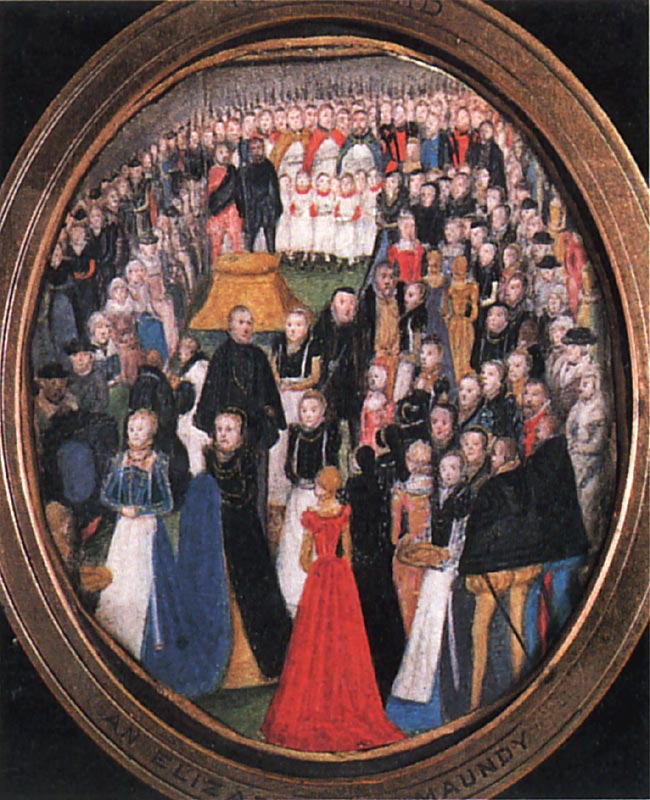
An Elizabethan Maundy
Fabric Color Myths
Myth: Blue colored garments are for servants only.
"Livery of a shade lighter than the midnight-sky-blue, but near the sky-blue of a clear October day, was the mark of servitude in the sixteenth century."
Also
" 'Seruingman wears broadcloth . . . and for his colours, they are according to the season; in the summer he is apparelled like the heauens in blew, in the winter, like the earth in freese', i.e. in russet. ". (1)
Blue was not just for servants during the 16th century, as Queen Elizabeth I is seen in An Elizabethan Maundy wearing a blue gown, as are other nobles in the image. The next myth shows blue wool of an appropriate servant's shade.
Maundy Thursday, as it "was an occasion for crown wearing and it was a day of mourning. As such, blue was an appropriate colour for the monarch to wear. According to the Great Chronicle Henry VI wore 'a long blew goune of velvet' n Maundy Thursday 1471.' " It seems Henry VIII preferred to wear violet clothing instead for Maundy Thursday. (2)
However, it is noted that Henry VIII did wear blue clothing on occassion. M. Hayward notes:
"The king rarely wore blue for his day-to-day wardrobe on account of its association with royal mourning. None the less, the king did wear blue, often in conjunction with yellow, along with the leading members of his court and household, for the clothes prepared for the jousts. Equally, blue was often associated with livery and blue formed part of the livery colours of the house of York (blue and murrey), Mary as Princess of Wales (blue and green) and the duke of Richmond (blue and yellow)." (3)
Mary Tudor in her inventory accounts rarely wore blue, it would seem. There were only two entries I found that specified blue for the garment, and they both seem to refer to the same gown. She seemed to prefer purple, crimson/scarlet, and black.
[26] Item for making lowse Gowne of blewe wrought furde vellat with raized lace of golde enbrauderid, of our store... and poynting Rebande. ...
[70] Item for facing and edging of a Gowne of blewe wrought furred vellat , to the same Gowne Thirtie and two Sable skynnes of our store [this gown may be identified with a loose gown, item 26] (4)
Queen Elizabeth had many items in her inventory accounts that were in blue fabric, as noted in Drea Leed's online database (blue items search) (5). Some of the items were made for others.
Blue dyes of the time period came from two sources, woad which was commonly used in England and other European sources, or True indigo (Indigofera tinctoria), a plant whose dyestuff was imported from India and other tropical places. Both contain the dye chemical also known as indigo or indigotin. Woad contains less of the dye-matter than true indigo, but both dyed fabrics blue. M. Hayward notes that "Woad was used to dye a range of blues varying in depth of shade from huling to plunket, watchet, azure and blue." (6)
Blue became associated with servants in the 17th century whose blue colored garments were similar to their masters. (7) Therefore those of high station might avoid blue garments in the 17th century.
As to the color use and material of blue in paintings, that is a different topic entirely, and will not be covered here.
An Elizabethan Maundy, attributed to Levina Teerlinc, c.1565.
(1) Linthicum, M.C., Costume in the Drama of Shakespeare and His Contemporaries. Pg 27, and note #3 on same page.
(2) Hayward, Maria. Dress at the Court of King Henry VIII, © 2007, pg 132-133.
(3) Hayward, pg 121
(4) Carter, Alison J. Mary Tudor's Wardrobe, Costume Journal, ©1984, pg 24-25
(5) Leed, Drea. Queen Elizabeth's Wardrobe Uploaded (http://www.elizabethancostume.net/qewu.html). ©2011
(6) Hayward, Maria. Dress at the Court of King Henry VIII, © 2007, , pg 121
(7) Linthicum, pg 27.
Page updated: July 9, 2011